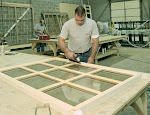Sometimes trends in the construction industry are reflected
in the strangest of places. I read an article about how the H&M clothing
store is struggling. For those of you who don’t have teenage daughters who are
always looking for cheap and stylish clothing, H&M is renowned for selling
low-priced, trendy clothing that might last for one season. They have mastered
the trade of selling disposable clothing. The fact that their sales are down
reflects a consumer trend that is moving towards quality and sustainability rather
than fashion. Consumers are being drawn towards classic designs that will last
for decades. Recently, I have seen this same trend towards quality and away
from throwaway building materials gaining momentum in the construction industry.
For the past thirty plus years, the construction industry
has concentrated on how to deliver a structure for the lowest possible price.
This obsession with lowering cost has driven manufacturers to pursue cheaper
materials and designs, and owners to squeeze every penny from the bidding
process. This “price is king” mentality consistently drove down quality of
design, materials, and labor to a point where class action lawsuits became the
resulting profitable industry. Just like the cheap blouse at H&M, windows, hardware,
appliances, plumbing fixtures, lighting, etc. are designed to reside in the
landfill after satisfying a ten-year warranty. But a growing dissatisfaction
with cheap construction practices has given birth to a refreshing trend towards
sustainability.
I first saw this movement towards quality reflected in my
business. Re-View Windows restores historic windows and manufactures historic replica
windows that are designed to perform for centuries. Our business model is based
upon quality, not price, and over the past 25 years, we have seen a consistent
demand for business. Our products are also designed to be easily maintained to
extend the life over several generations. One doesn’t have to look far for
other examples of the drive towards quality and sustainable design:
- The Green Building Movement which has previously focused on energy efficiency has expanded to concentrate on sustainability and recyclability. The life cycle of a building is a critical factor in this program.
- The use of recyclable materials is expanding in all areas of the construction industry with materials such as aluminum, glass, and wood gaining acceptance at the expense of petroleum-based products like vinyl.
- The glass industry is shifting its priorities from energy efficiency to quality. “We became myopic about energy efficiency…now we are starting to think in terms of life cycle,” said Mic Patterson of Schuco USA.
- The need for increased strength has long driven the concrete industry for years. Now, due to the escalation in repair and replacement costs, manufactures are paying more attention to durability than strength.
- Commercial project bidding practices are evolving as evidenced by the increasing popularity of the Integrated Project Delivery (IPD) method. Rather than basing the reward of a project on lowest price, this method connects the owner, design team, and key subcontractors to work together from design through implementation.
- Building Information Modeling (BIM) has adopted a “circular construction” model where materials stay in play for longer, getting reused or recycled whenever possible. Buildings are being viewed as “material banks” and the bill of materials captured by BIM facilitates reuse.
- The use of independent quality control of construction processes is more widely used than ever before. At Re-View, for example, we have glazing, finishes, sealants, and other elements tested by independent agencies on a regular basis.
practices gain a foothold. It’s been missing
for far too long, resulting in added job expense in the form of rework, missed
deadlines, and shoddy workmanship. When construction quality suffers, the
industry as a whole suffers. I’m hopeful that as we move into 2019, we’ll see a
greater emphasis on
quality control and personal ownership of all aspects of the
end product. For now, since my daughters
are both grown, I’m just glad my days
of purchasing sub-standard clothing at H&M are over.




